A Simplified Method for an Evaluation of the Effect of Submerged Breakwaters on Wave Damping: The Case Study of Calabaia Beach
Abstract
:1. Introduction
2. Materials and Methods
2.1. The Mathematical Model
- Sin is the wind action;
- Snl is the waves non-linear interaction;
- Sds is the white capping effect;
- Sbot is the bottom dissipative action;
- Ssurf is the dissipation due to wave breaking phenomena.
- is the sediment flux normalized to the face of the element;
- is the lenght of the face of the element;
- is the index of the element;
2.2. Submerged Breakwaters
2.3. The Study Area: Calabaia Beach
2.4. Model Set-Up
3. Results
4. Application at Calabaia Beach
5. Conclusion
Author Contributions
Funding
Acknowledgments
Conflicts of Interest
References
- Alexandrakis, G.; Manasakis, C.; Kampanis, N.A. Valuating the effects of beach erosion to tourism revenue. A management perspective. Ocean Coast. Manag. 2015, 111, 1–11. [Google Scholar] [CrossRef]
- Roebeling, P.C.; Costa, L.; Magalhães-Filho, L.; Tekken, V. Ecosystem service value losses from coastal erosion in Europe: Historical trends and future projections. J. Coast. Conserv. 2013, 17, 389–395. [Google Scholar] [CrossRef]
- Folke, C.; Biggs, R.; Norström, A.V.; Reyers, B.; Rockström, J. Social-ecological resilience and sustainability. Ecol. Soc. 2016, 21, 41. [Google Scholar] [CrossRef]
- Leslie, H.M.; Basurto, X.; Nenadovic, M.; Sievanen, L.; Cavanaugh, K.C.; Cota-Nieto, J.J.; Erisman, B.E.; Finkbeiner, E.; Hinojosa-Arango, G.; Moreno-Báez, M.; et al. Operationalizing the social-ecological systems framework to assess sustainability. Proc. Natl. Acad. Sci. USA 2015, 112, 5979–5984. [Google Scholar] [CrossRef] [Green Version]
- Sun, C.; Zhang, K.; Zou, W.; Li, B.; Qin, X. Assessment and Evolution of the Sustainable Development Ability of Human–Ocean Systems in Coastal Regions of China. Sustainability 2015, 7, 1–29. [Google Scholar] [CrossRef] [Green Version]
- Mele, B.H.; Russo, L.; D’Alelio, D. Combining marine ecology and economy to roadmap the integrated coastal management: A systematic literature review. Sustainability 2019, 11, 4393. [Google Scholar] [CrossRef] [Green Version]
- Nicholls, R.J. Coastal Megacities and Climate Change. GeoJournal 1995, 37, 369–379. [Google Scholar] [CrossRef]
- De Zolt, S.; Lionello, P.; Nuhu, A.; Tomasin, A. The disastrous storm of 4 November 1966 on Italy. Nat. Hazards Earth Syst. Sci. 2006, 6, 861–879. [Google Scholar] [CrossRef] [Green Version]
- Mel, R.; Sterl, A.; Lionello, P. High resolution climate projection of storm surge at the Venetian coast. Nat. Hazards Earth Syst. Sci. 2013, 13, 1135–1142. [Google Scholar] [CrossRef] [Green Version]
- Mel, R.; Lionello, P. Verification of an ensemble prediction system for storm surge forecast in the Adriatic Sea. Ocean Dyn. 2014, 64, 1803–1814. [Google Scholar] [CrossRef]
- Mel, R.; Lionello, P. Probabilistic dressing of a storm surge prediction in the Adriatic Sea. Adv. Meteorol. 2016, 2016, 3764519. [Google Scholar] [CrossRef] [Green Version]
- Pranzini, E.; Wetzel, A.; Williams, A. Aspects of coastal erosion and protection in Europe. J. Coast. Conserv. 2015, 19. [Google Scholar] [CrossRef]
- Bendoni, M.; Mel, R.; Solari, L.; Lanzoni, S.; Francalanci, S.; Oumeraci, H. Insights into lateral marsh retreat mechanism through localized field measurements. Water Resour. Res. 2016, 52, 1446–1464. [Google Scholar] [CrossRef] [Green Version]
- Finotello, A.; Marani, M.; Carniello, L.; Pivato, M.; Roner, M.; Tommasini, L.; D’alpaos, A. Control of wind-wave power on morphological shape of salt marsh margins. Water Sci. Eng. 2020. [Google Scholar] [CrossRef]
- Huang, W. The Influence of Cruise Tourism Dining Waste on the Process of Self-recovery of Natural Ecological Environment. Ekoloji 2019, 28, 49–54. [Google Scholar]
- Lamine, I.; Alla, A.A.; Bourouache, M.; Moukrim, A. Monitoring of physicochemical and microbiological quality of Taghazout seawater (Southwest of Morocco): Impact of the new tourist resort “Taghazout bay”. J. Ecol. Eng. 2019, 20, 79–89. [Google Scholar] [CrossRef]
- McKenna, J.; Cooper, A.; O’Hagan, A.M. Managing by principle: A critical analysis of the European principles of Integrated Coastal Zone Management (ICZM). Mar. Policy 2008, 32, 941–955. [Google Scholar] [CrossRef]
- Pope, J. Responding to coastal erosion and flooding damages. J. Coast. Res. 1997, 13, 704–710. [Google Scholar]
- Sakamoto, R.; Seino, S.; Suzaki, H. Coastal Alteration and Changes in Shoreline Morphology Due To Artificial Structures in Miiraku Town on Fukue Is. in the Goto Archipelago. In Proceedings of the EMECS 11-Sea Coasts XXVI. Joint Conference. Managing Risks to Coastal Regions and Communities in a Changing World, Saint Petersburg, Russia, 22–27 August 2016. [Google Scholar]
- Reeve, D.E.; Spivack, M. Stochastic prediction of long-term coastal evolution. Environ. Stud. 2001, 58, 55–64. [Google Scholar]
- EUROSION. Living with Coastal Erosion in Europe: Sediment and Space for Sustainability—PART I—Major Findings and Policy Recommendations of the EUROSION Project. In Results from the Eurosion study; European Commission: Luxembourg, 2004; p. 54. [Google Scholar]
- Post, J.C.; Lundin, C.G. Guidelines for Integrated Coastal Zone Management; The World Bank: Washington, WA, USA, 1996; Volume 9, ISBN 0821337351. [Google Scholar]
- OECD. The Ocean Economy in 2030; OECD Publishing: Paris, France, 2016. [Google Scholar]
- Seixas, C.S.; Davidson-hunt, I.; Kalikoski, D.C.; Davy, B.; Berkes, F.; de Castro, F.; Medeiros, R.P.; Minte-vera, C.V.; Araujo, L.G. Collaborative Coastal Management in Brazil: Advancements, Challenges, and Opportunities. In Viability and Sustainability of Small-Scale Fisheries in Latin America and The Caribbean; Springer: Cham, Switzerland, 2019; pp. 421–451. ISBN 9783319760780. [Google Scholar]
- Crain, C.M.; Halpern, B.S.; Beck, M.W.; Kappel, C.V. Understanding and managing human threats to the coastal marine environment. Ann. N. Y. Acad. Sci. 2009, 1162, 39–62. [Google Scholar] [CrossRef]
- Maiolo, M.; Pantusa, D. Sustainable Water Management Index, SWaM_Index. Cogent Eng. 2019, 6, 1–14. [Google Scholar] [CrossRef]
- Ondiviela, B.; Losada, I.J.; Lara, J.L.; Maza, M.; Galván, C.; Bouma, T.J.; van Belzen, J. The role of seagrasses in coastal protection in a changing climate. Coast. Eng. 2014, 87, 158–168. [Google Scholar] [CrossRef]
- Spalding, M.D.; Ruffo, S.; Lacambra, C.; Meliane, I.; Hale, L.Z.; Shepard, C.C.; Beck, M.W. The role of ecosystems in coastal protection: Adapting to climate change and coastal hazards. Ocean Coast. Manag. 2014, 90, 50–57. [Google Scholar] [CrossRef]
- Cantasano, N. Posidonia Oceanica per la Difesa Degli Ambienti. In Proceedings of the SOS Dune, Roma, Italy, 11–18 May 2014; pp. 170–183. [Google Scholar]
- Callaghan, D.; Ranasinghe, R.; Nielsen, P.; Larson, M.; Short, A. Process-determined coastal erosion hazards. Proc. Coast. Eng. Conf. 2009, 5, 4227–4236. [Google Scholar]
- Li, X.; Zhang, W. 3D numerical simulation of wave transmission for low-crested and submerged breakwaters. Coast. Eng. 2019, 152, 103517. [Google Scholar] [CrossRef]
- Hur, D.S.; Lee, W.D.; Cho, W.C. Three-dimensional flow characteristics around permeable submerged breakwaters with open inlet. Ocean Eng. 2012, 44, 100–116. [Google Scholar] [CrossRef]
- Hur, D.S.; Lee, W.D.; Cho, W.C. Characteristics of wave run-up height on a sandy beach behind dual-submerged breakwaters. Ocean Eng. 2012, 45, 38–55. [Google Scholar] [CrossRef]
- Sharifahmadian, A.; Simons, R.R. A 3D numerical model of nearshore wave field behind submerged breakwaters. Coast. Eng. 2014, 83, 190–204. [Google Scholar] [CrossRef]
- Sorensen, R.M.; Beil, N.J. Perched beach profile response to wave action. In Proceedings of the 21st International Conference on Coastal Engineering, Malaga, Spain, 20–25 June 1988; pp. 1482–1492. [Google Scholar]
- González, M.; Medina, R.; Losada, M.A. Equilibrium beach profile model for perched beaches. Coast. Eng. 1999, 36, 343–357. [Google Scholar] [CrossRef]
- Sollitt, C.K.; Cross, R.H.; Engineer, C. Wave Transmission Through Permeable Breakwaters. Coast. Eng. 1972, 1827–1846. [Google Scholar]
- Rahimzadeh, A.; Ghadimi, P.; Feizi Chekab, M.A.; Jabbari, M.H. Determining transmission coefficient of propagating solitary wave over trapezoidal breakwater and parametric studies on different influential factors. ISRN Mech. Eng. 2014, 2014, 841327. [Google Scholar] [CrossRef]
- Anastasiau, K.; Chan, C.T. Solution of the 2D shallow water equations using the finite-volume method on unstructured triangular meshes. Int. J. Numer. Methods Fluids 1997, 24, 1225–1245. [Google Scholar] [CrossRef]
- Komen, G.J.; Cavaleri, L.; Doneland, M.; Hasselmann, K.; Hasselmann, S.; Janssen, P.A.E.M. Dynamics and Modelling of Ocean Waves; Cambridge University Press: New York, NY, USA, 1994; ISBN 0-521-47047-1. [Google Scholar]
- Young, I.R. Wind Generated Ocean Waves; Elsevier: Amsterdam, The Netherlands, 1999; Volume 2, ISBN 9780080433172. [Google Scholar]
- Ekebjærg, L.; Justesenu, P. An explicit scheme for advection-diffusion modelling in two dimensions. Comput. Methods Appl. Mech. Eng. 1991, 88, 287–297. [Google Scholar] [CrossRef]
- Mel, R.; Carniello, L.; D’Alpaos, L. Addressing the effect of the Mo.S.E. barriers closure on wind setup within the Venice lagoon. Estuar. Coast. Shelf Sci. 2019, 225, 106249. [Google Scholar] [CrossRef]
- Mel, R.; Carniello, L.; D’Alpaos, L. Dataset of wind setup in a regulated Venice lagoon. Data Br. 2019, 26, 104386. [Google Scholar] [CrossRef] [PubMed]
- Syvitski, J.P.M.; Slingerland, R.L.; Burgess, P.; Murray, A.B.; Wiberg, P.; Tucker, G.; Voinov, A. Morphodynamic models: An overview. In River, Coastal and Estuarine Morphodynamics: RCEM 2009; Vionnet, C.A., Garcia, M.H., Latrubesse, E.M., Perillo, G.M.E., Eds.; Taylor & Francis: London, UK, 2010; pp. 3–20. [Google Scholar]
- Short, A.D.; Jackson, D.W.T. Beach Morphodynamics. In Treatise on Geomorphology; Shroder, J.F., Ed.; Academic Press: San Diego, CA, USA, 2013; Volume 10, pp. 106–129. [Google Scholar]
- Hamza, W.; Tomasicchio, G.R.; Ligorio, F.; Lusito, L.; Francone, A. A Nourishment Performance Index for Beach Erosion/Accretion at Saadiyat Island in Abu Dhabi. J. Mar. Sci. Eng. 2019, 7, 173. [Google Scholar] [CrossRef] [Green Version]
- Danish Hydraulics Institute (DHI). MIKE 21 & MIKE 3 Flow Model FM—Hydrodynamic and Transport Module, Scientific Documentation; DHI, Ed.; DHI: Hørsholm, Denmark, 2017. [Google Scholar]
- Roe, P.L. Approximate Riemann Solvers, Parameter Vectors, and Difference Sschemes. J. Comput. Phys. 1997, 135, 250–258. [Google Scholar] [CrossRef] [Green Version]
- Jawahar, P.; Kamath, H. A High-Resolution Procedure for Euler and Navier-Stokes Computations on Unstructured Grids. J. Comput. Phys. 2000, 164, 165–203. [Google Scholar] [CrossRef]
- Battjes, J.A.; Janssen, J.P.F.M. Energy oss and Set-up due to breaking of random waves. Coast. Eng. 1978, 569–587. [Google Scholar]
- Eldeberky, Y.; Battjes, J.A. Spectral modeling of wave breaking: Application to Boussinesq equations. J. Geophys. Res. 1996, 101, 1253–1264. [Google Scholar] [CrossRef]
- Nelson, R.C. Design wave heights on very mild slopes—An Experimental Study. Trans. Inst. Eng. Aust. Civ. Eng. 1987, 3, 157–161. [Google Scholar]
- Nelson, R.C. Depth limited design wave heights in very flat regions. Coast. Eng. 1994, 23, 43–59. [Google Scholar] [CrossRef]
- Ruessink, B.G.; Walstra, D.J.R.; Southgate, H.N. Calibration and verification of a parametric wave model on barred beaches. Coast. Eng. 2003, 48, 139–149. [Google Scholar] [CrossRef]
- Danish Hydraulics Institute (DHI). MIKE 21 Sand Transport Module, Scientific Documentation; DHI, Ed.; DHI: Hørsholm, Denmark, 2017. [Google Scholar]
- Aagaard, T.; Nielsen, J.; Jensen, S.G.; Friderichsen, J. Longshore sediment transport and coastal erosion at Skallingen, Denmark. Geogr. Tidsskr. 2004, 104, 5–14. [Google Scholar] [CrossRef]
- Elfrink, B.; Brøker, I.; Deigaard, R.; Asp Hansen, E.; Justesen, P. Modelling of 3D sediment transport in the surf zone. Coast. Eng. 1996, 3805–3817. [Google Scholar]
- Murillo, J.; García-Navarro, P. An Exner-based coupled model for two-dimensional transient flow over erodible bed. J. Comput. Phys. 2010, 229, 8704–8732. [Google Scholar] [CrossRef]
- Danish Hydraulics Institute (DHI). MIKE 21 Spectral Wave Module, Scientific Documentation; DHI, Ed.; DHI: Hørsholm, Denmark, 2017. [Google Scholar]
- Goda, Y.; Takeda, H. Laboratory Investigation on Wave Transmission over Breakwater; The Port and Harbour Research Institute: Yokosuka, Japan, 1967; Volume 8. [Google Scholar]
- Goda, Y. Re-analysis of Laboratory Data on Wave Transmission over Breakwaters; The Port and Harbour Research Institute: Yokosuka, Japan, 1969; Volume 8. [Google Scholar]
- Viero, D.P.; D’Alpaos, A.; Carniello, L.; Defina, A. Mathematical modeling of flooding due to river bank failure. Adv. Water Resour. 2013, 59, 82–94. [Google Scholar] [CrossRef]
- Viero, D.P.; Defina, A. Multiple states in the flow through a sluice gate. J. Hydraul. Res. 2019, 57, 39–50. [Google Scholar] [CrossRef] [Green Version]
- Mel, R.; Viero, D.P.; Carniello, L.; D’Alpaos, L. Optimal floodgate operation for river flood management: The case study of Padova (Italy). J. Hydrol. Reg. 2020, 30, 100702. [Google Scholar] [CrossRef]
- Mel, R.A.; Viero, D.P.; Carniello, L.; D’Alpaos, L. Multipurpose use of artificial channel networks for flood risk reduction: The case of the waterway Padova–Venice (Italy). Water 2020, 12, 1609. [Google Scholar] [CrossRef]
- Maiolo, M.; Versace, P.; Natale, L.; Irish, J.; Pope, J.; Frega, F. A comprehensive study of the tyrrhenian shoreline of the Province of Cosenza. In Proceedings of the AIPCN 2000—Giornate Italiane di Ingegneria Costiera V Edizione, Reggio Calabria, Italy, 11–13 October 2000. [Google Scholar]
- Rubio, C.M. A laboratory procedure to determine the thermal properties of silt loam soils based on ASTM D 5334. Appl. Ecol. Environ. Sci. 2013, 1, 45–48. [Google Scholar]
- U.S.A.C.E.-C.H.L.; U.S. Army Corps of Engineers (USACE) Coastal and Hydraulics Laboratory (CHL)—Centro Studi di Ingegneria Ambientale (CSdIA) Analisi Regionale del Litorale della Provincia di Cosenza, Provincia di Cosenza Ed. 2000.
- Orlanski, I. A simple boundary condition for unbounded hyperbolic flows. J. Comput. Phys. 1976, 21, 251–269. [Google Scholar] [CrossRef]
- Chapman, D.C. Numerical treatment of cross-shelf open boundaries in a barotropic coastal ocean model. J. Phys. Oceanogr. 1985, 15, 1060–1075. [Google Scholar] [CrossRef] [Green Version]
- Shabangu, P.E. Investigation of a Simplified Open Boundary Condition for Coastal and Shelf Sea Hydrodynamic Models. Ph.D. Thesis, Stellenbosch University, Stellenbosch, South Africa, March 2015. [Google Scholar]
- Hur, D.S.; Lee, W.D.; Cho, W.C.; Jeong, Y.H.; Jeong, Y.M. Rip current reduction at the open inlet between double submerged breakwaters by installing a drainage channel. Ocean. Eng. 2019, 193, 106580. [Google Scholar] [CrossRef]
- Goda, Y.; Ahrens, J.P. New formulation of wave transmission over and through low-crested structures. Coast. Eng. 2009, 5, 3530–3541. [Google Scholar]
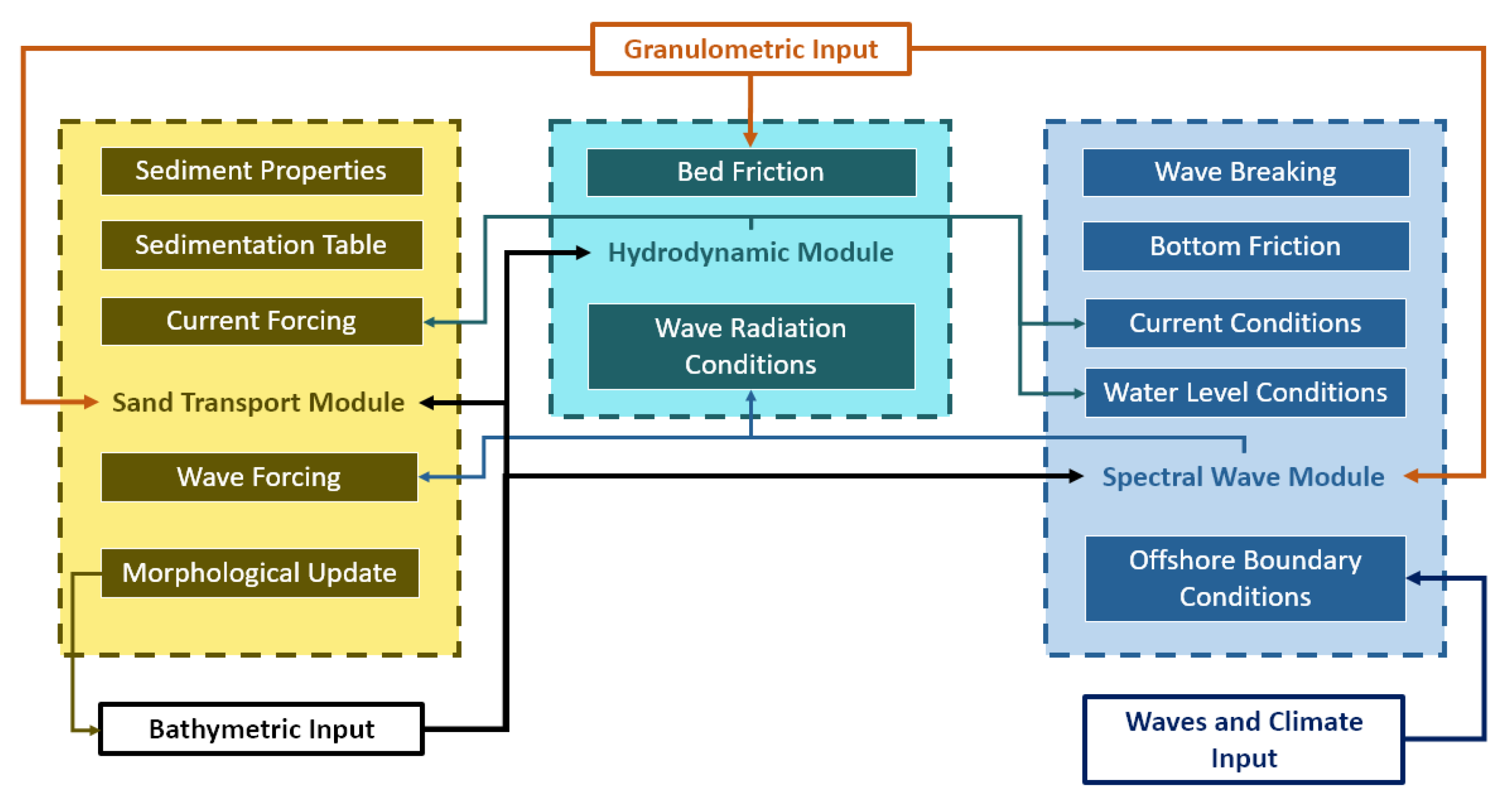
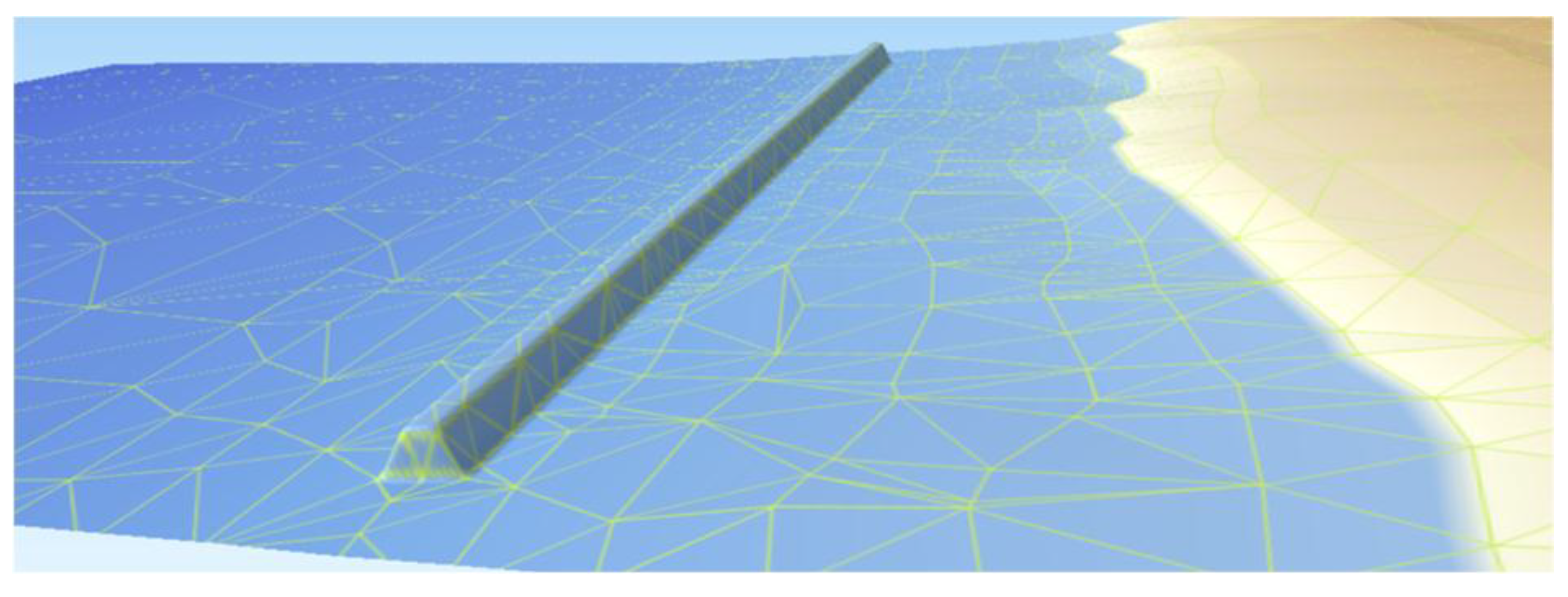

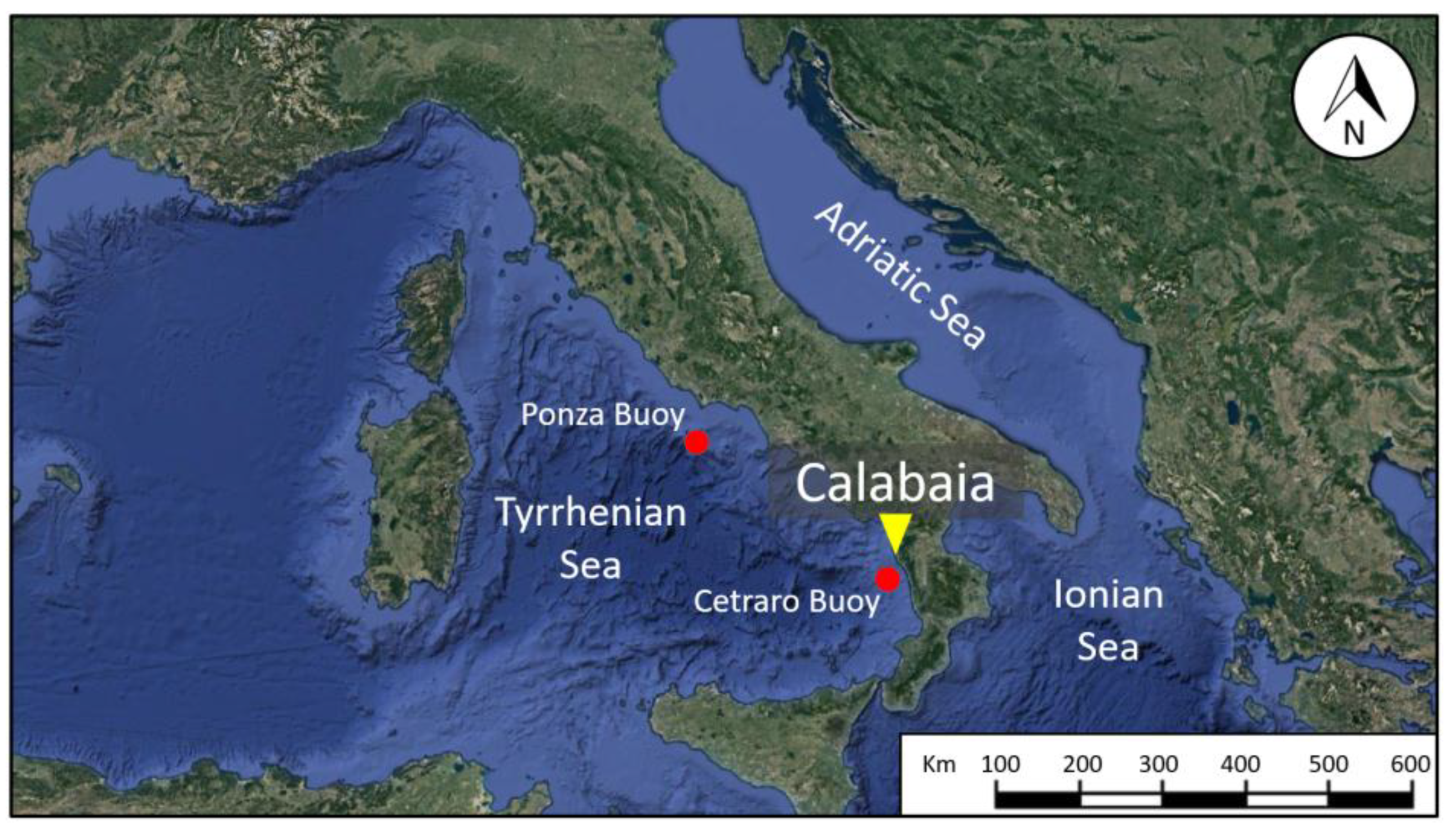
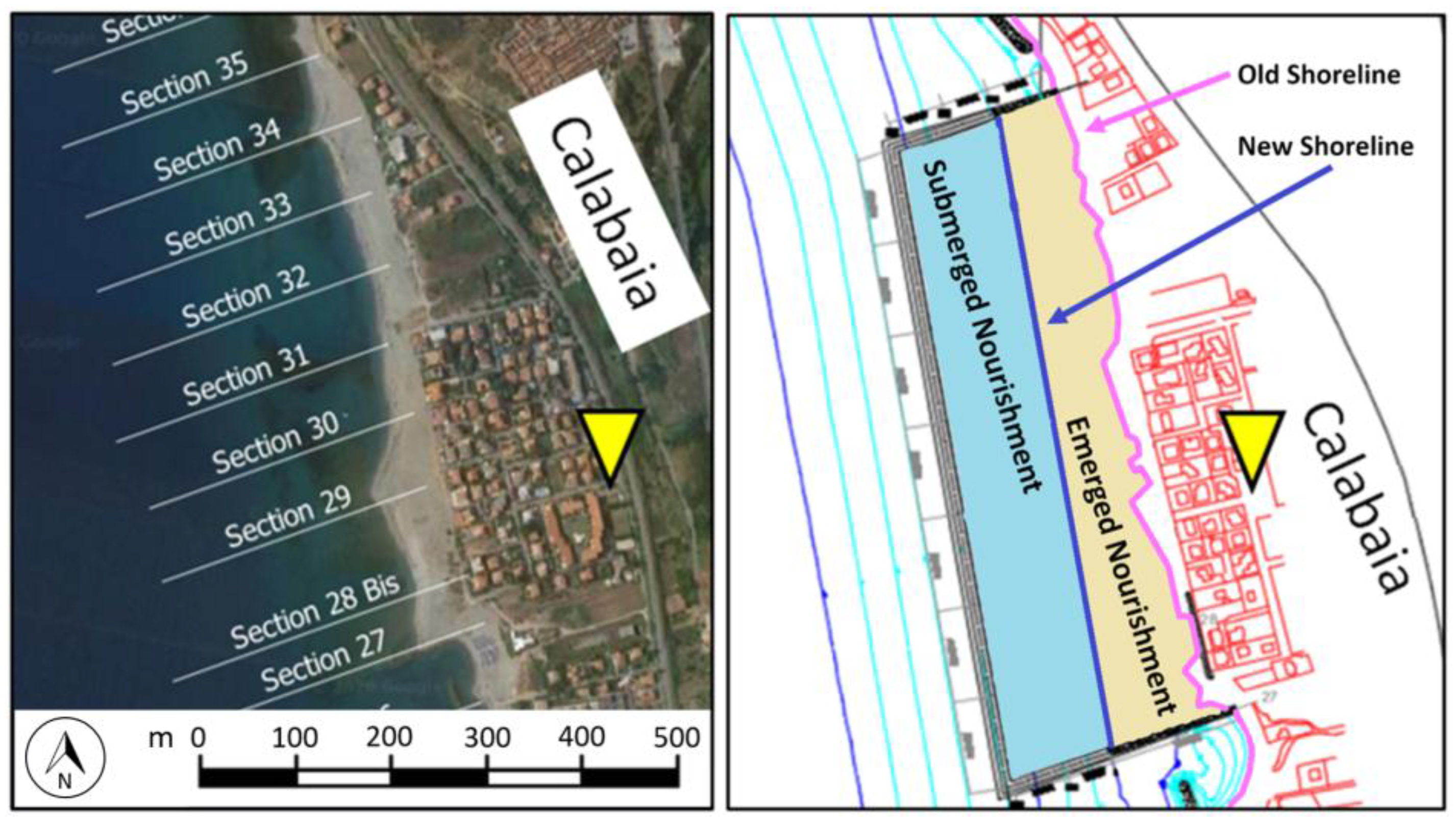

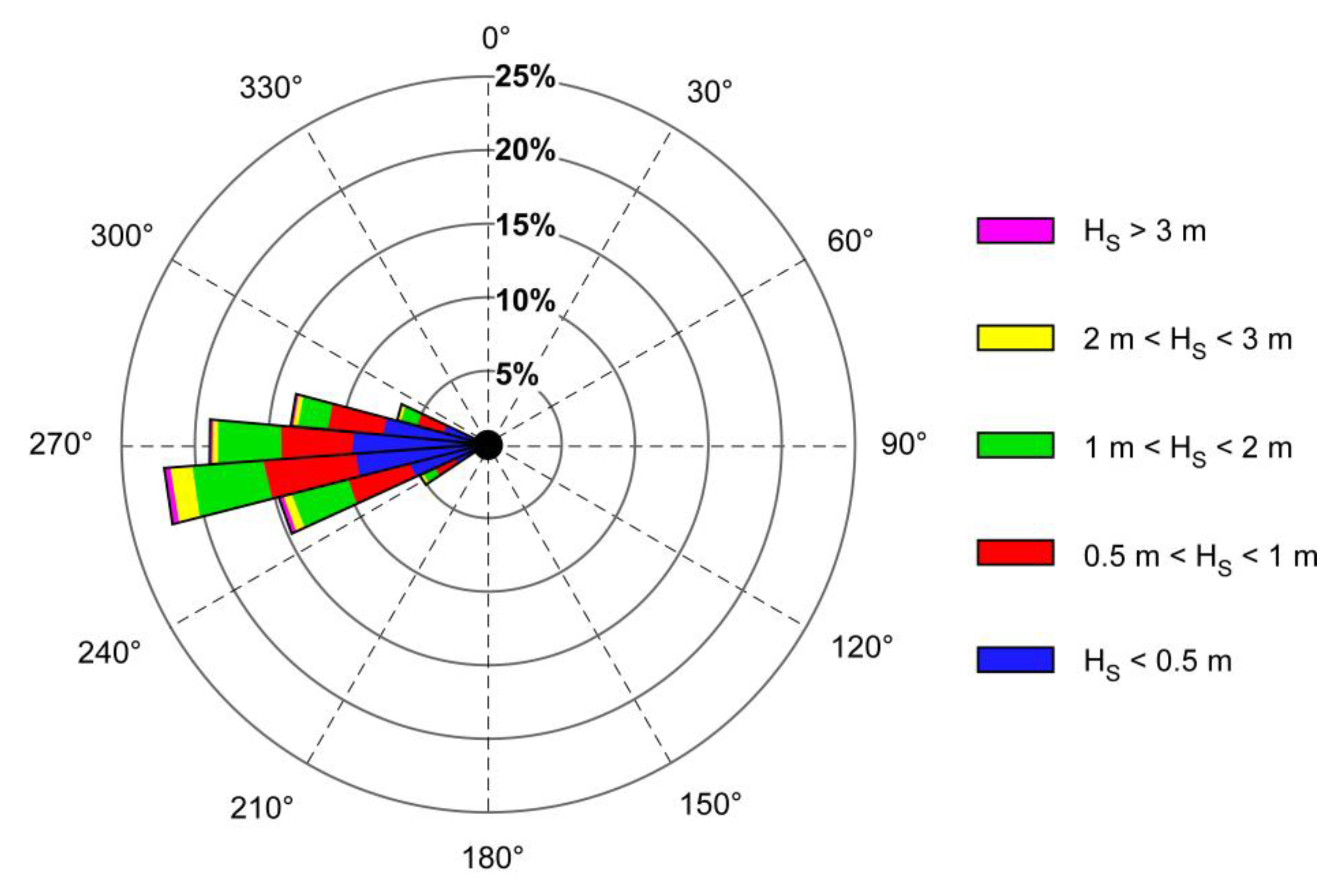
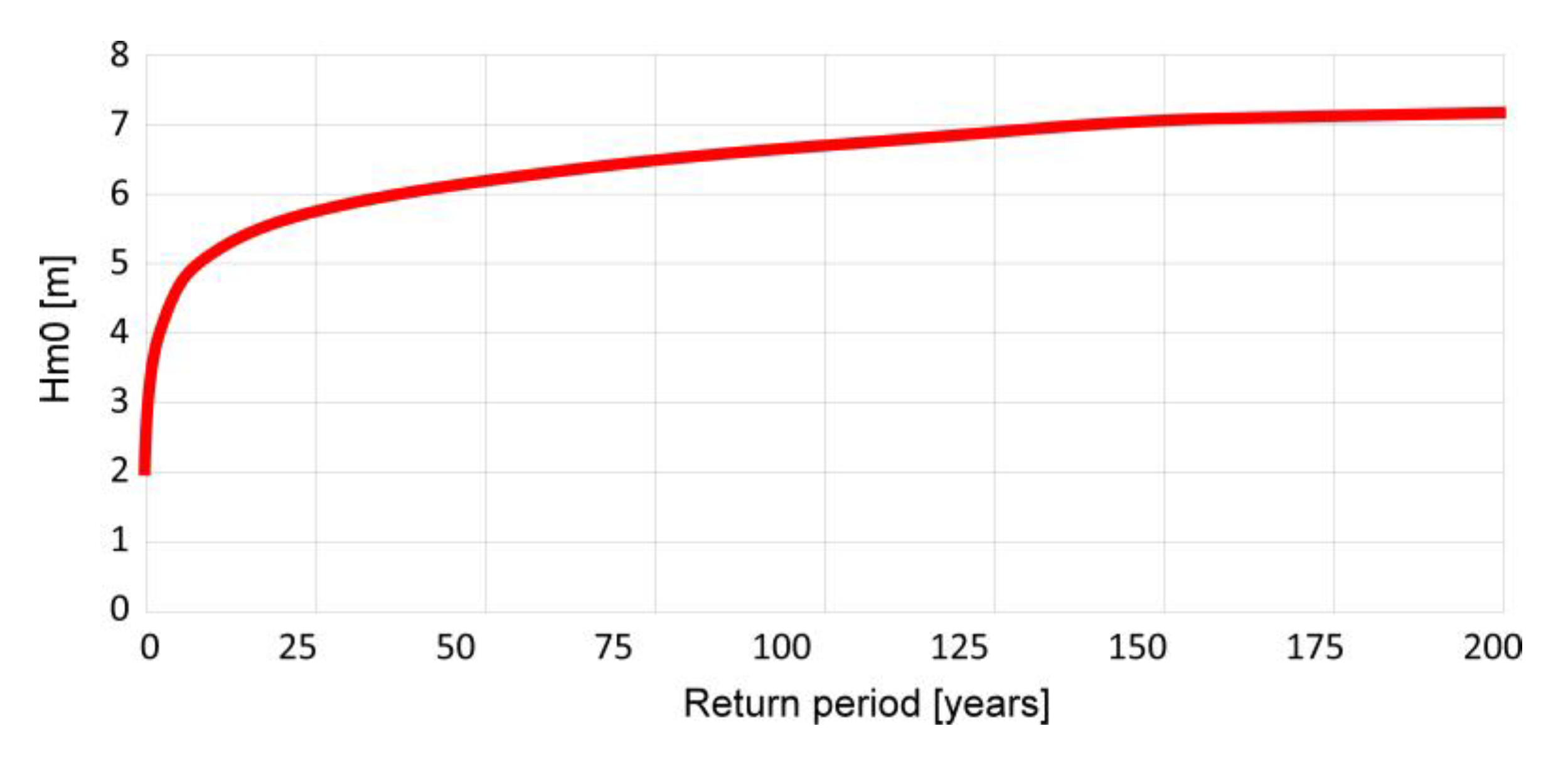
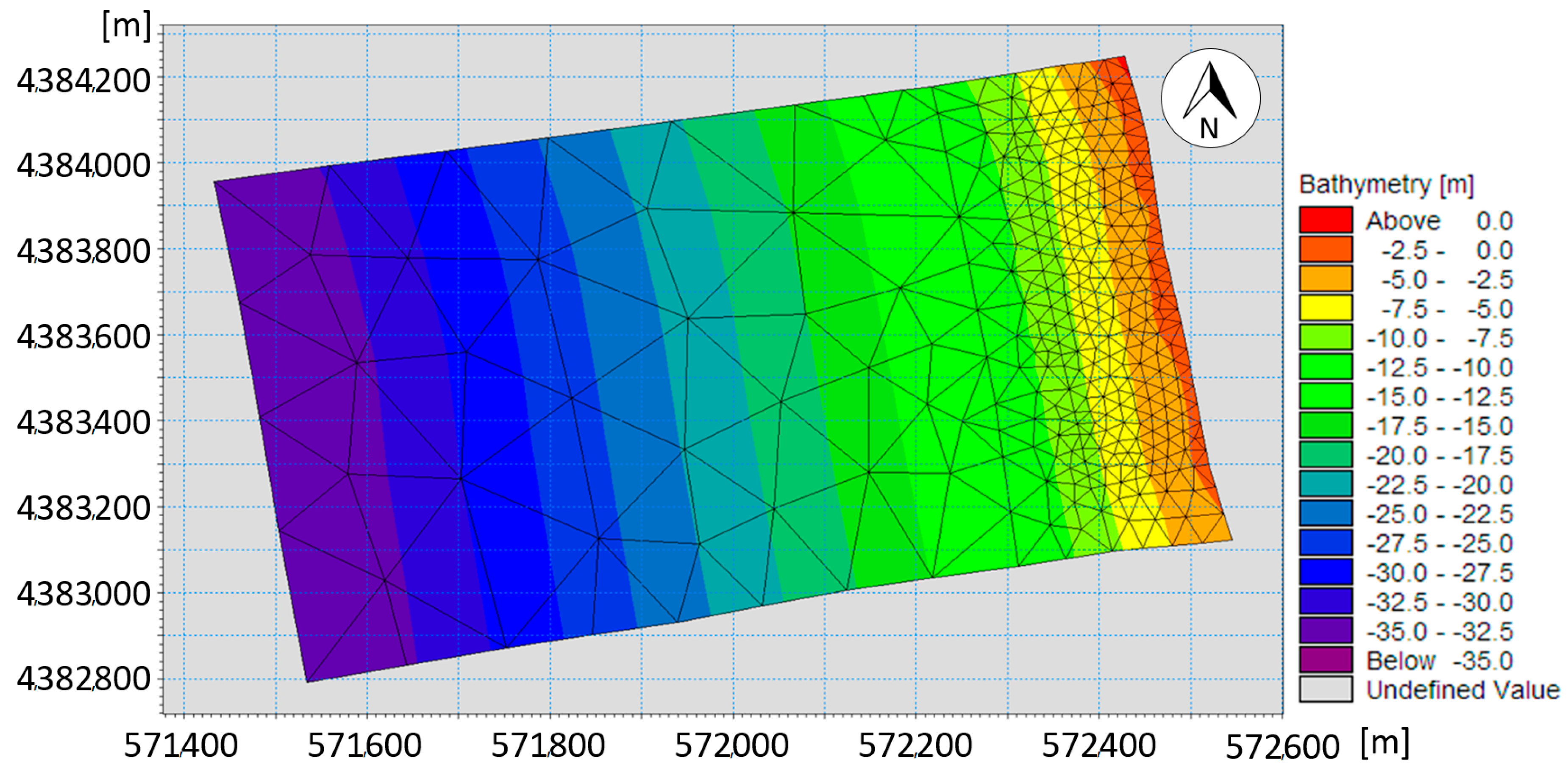
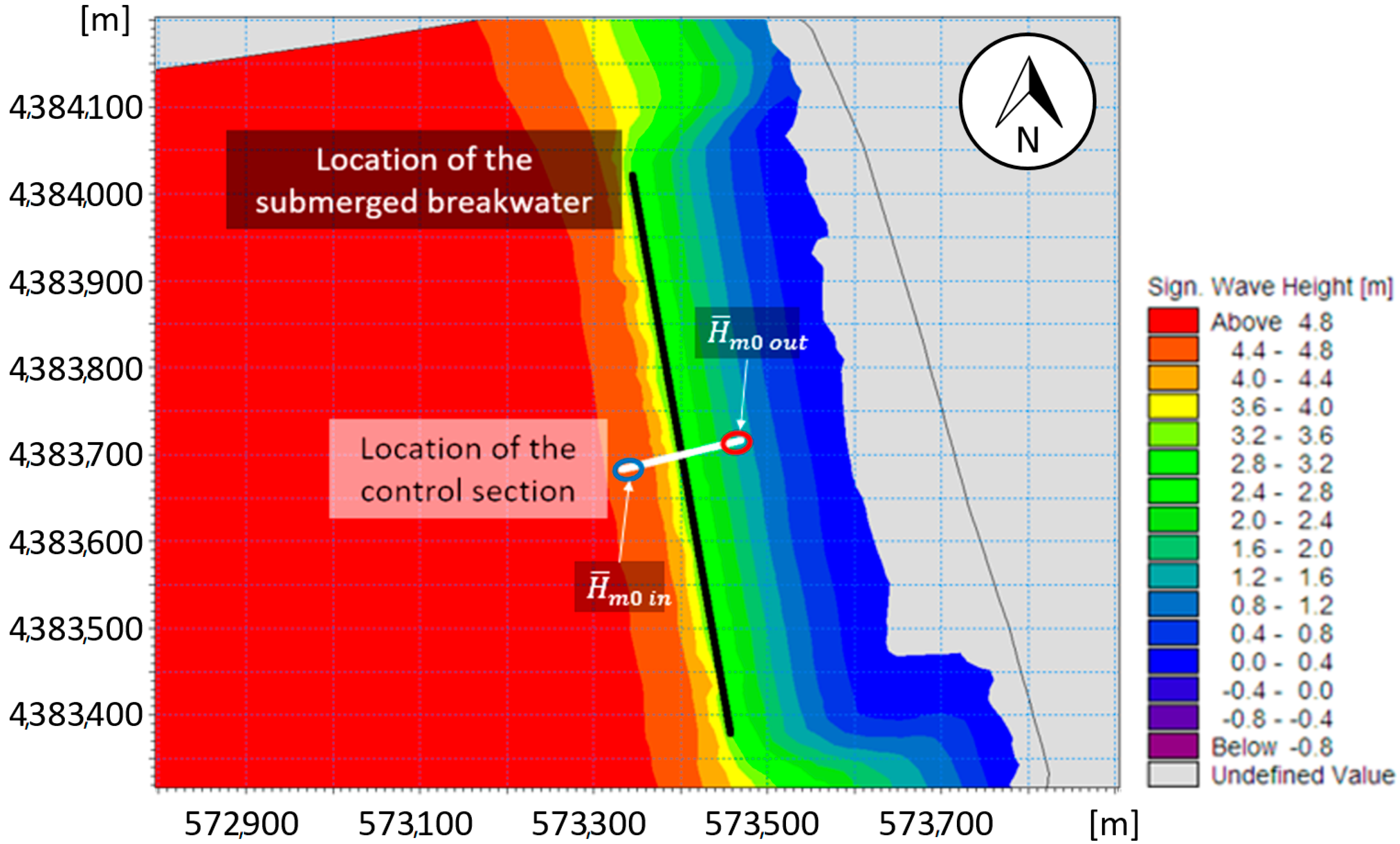
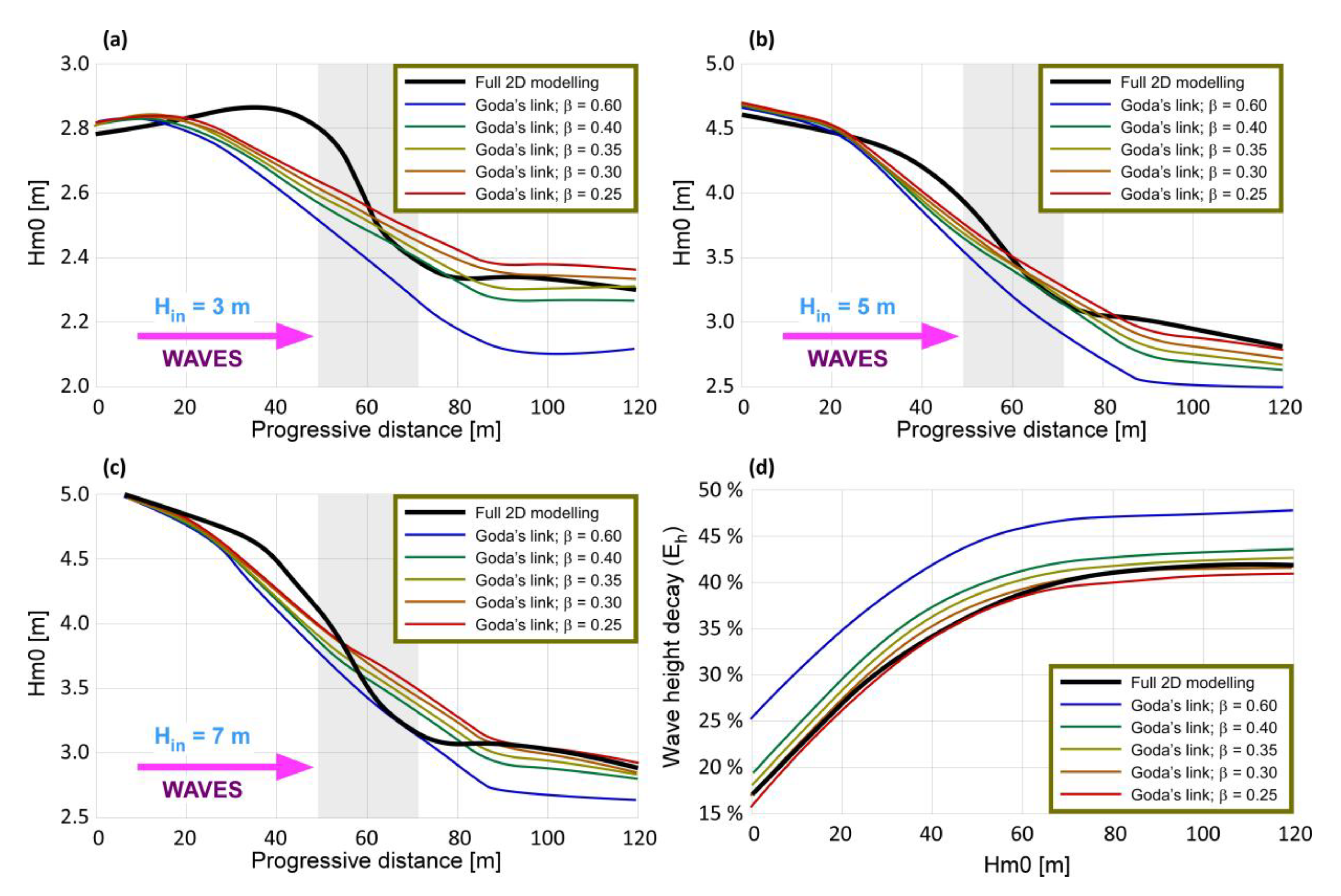
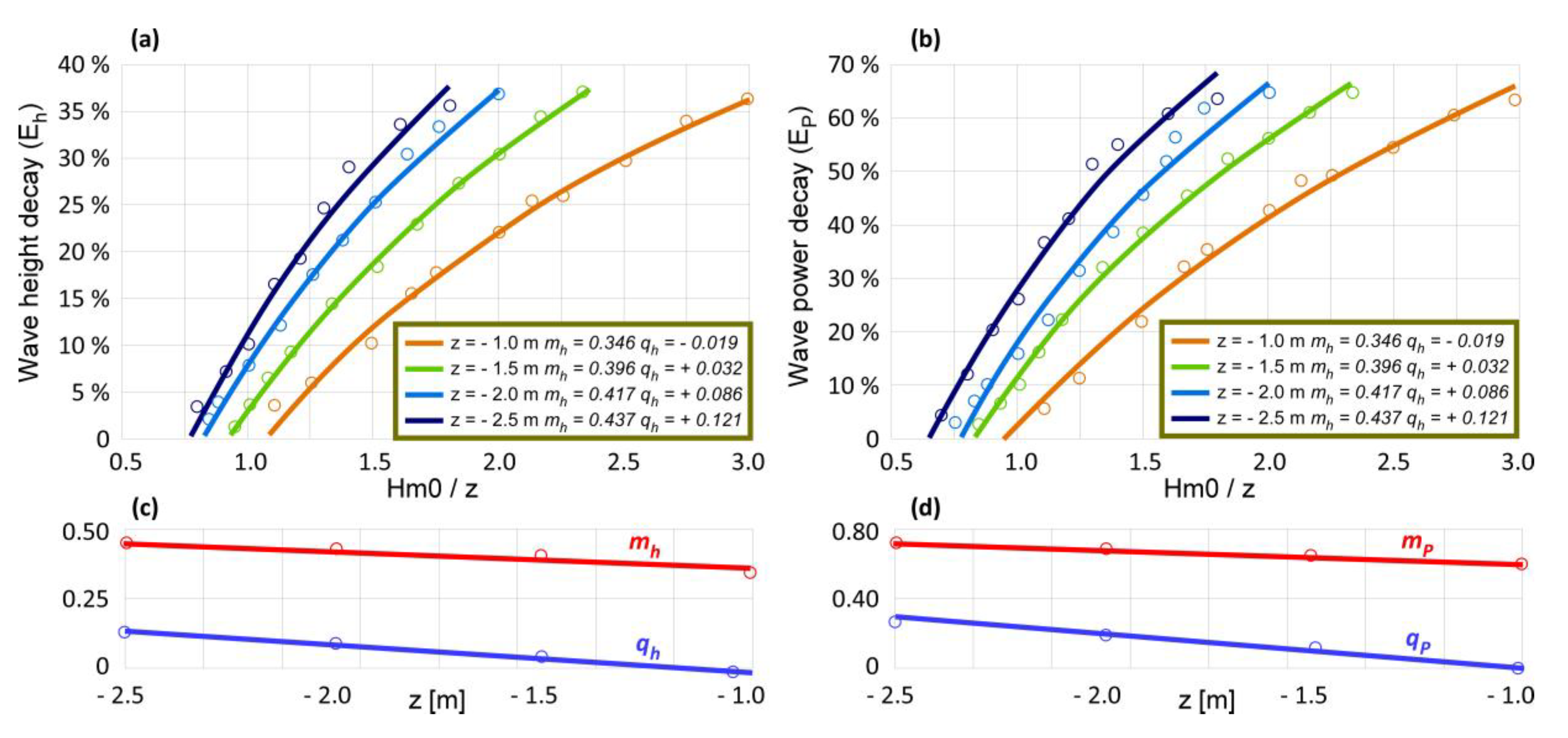
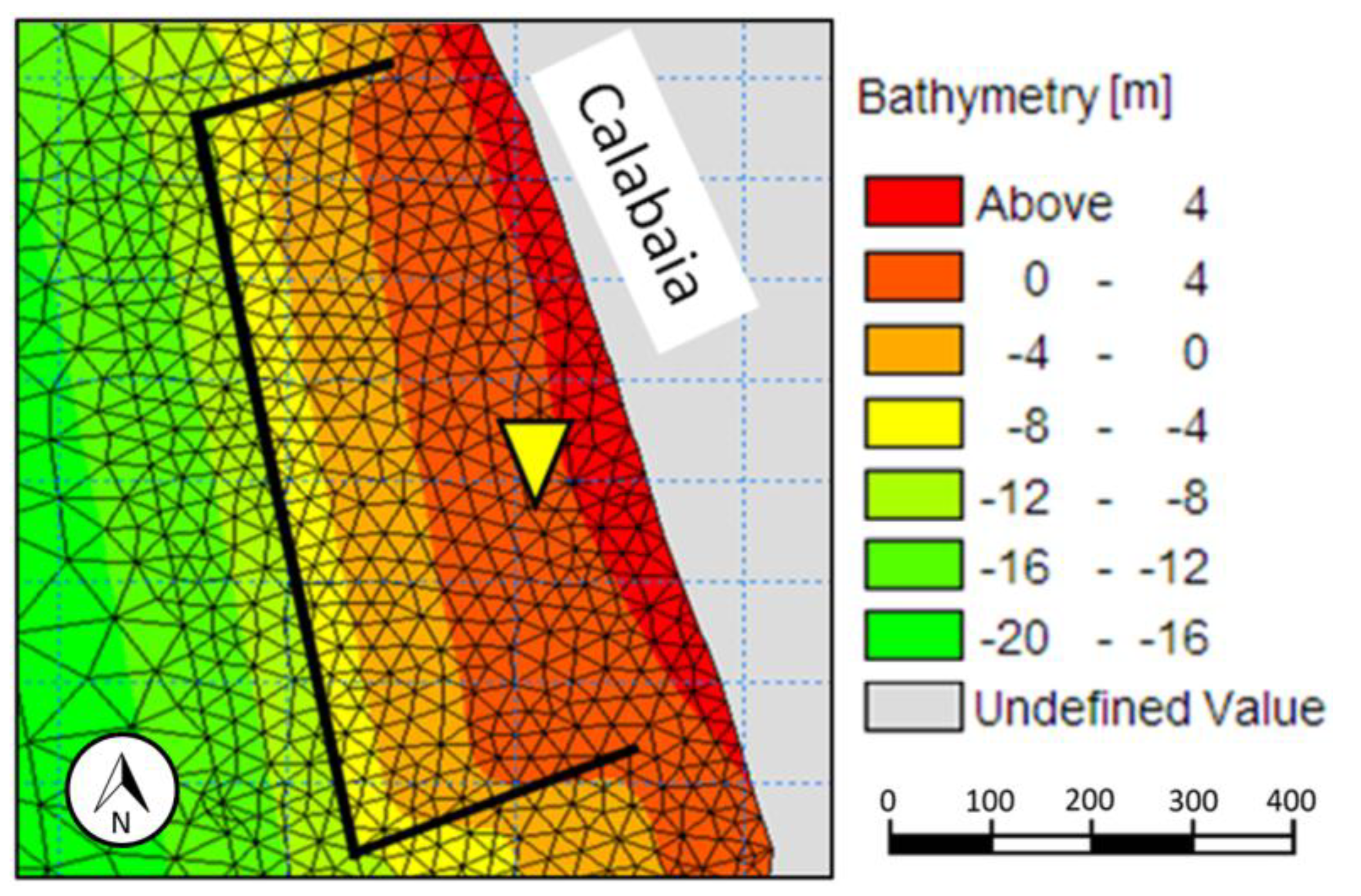
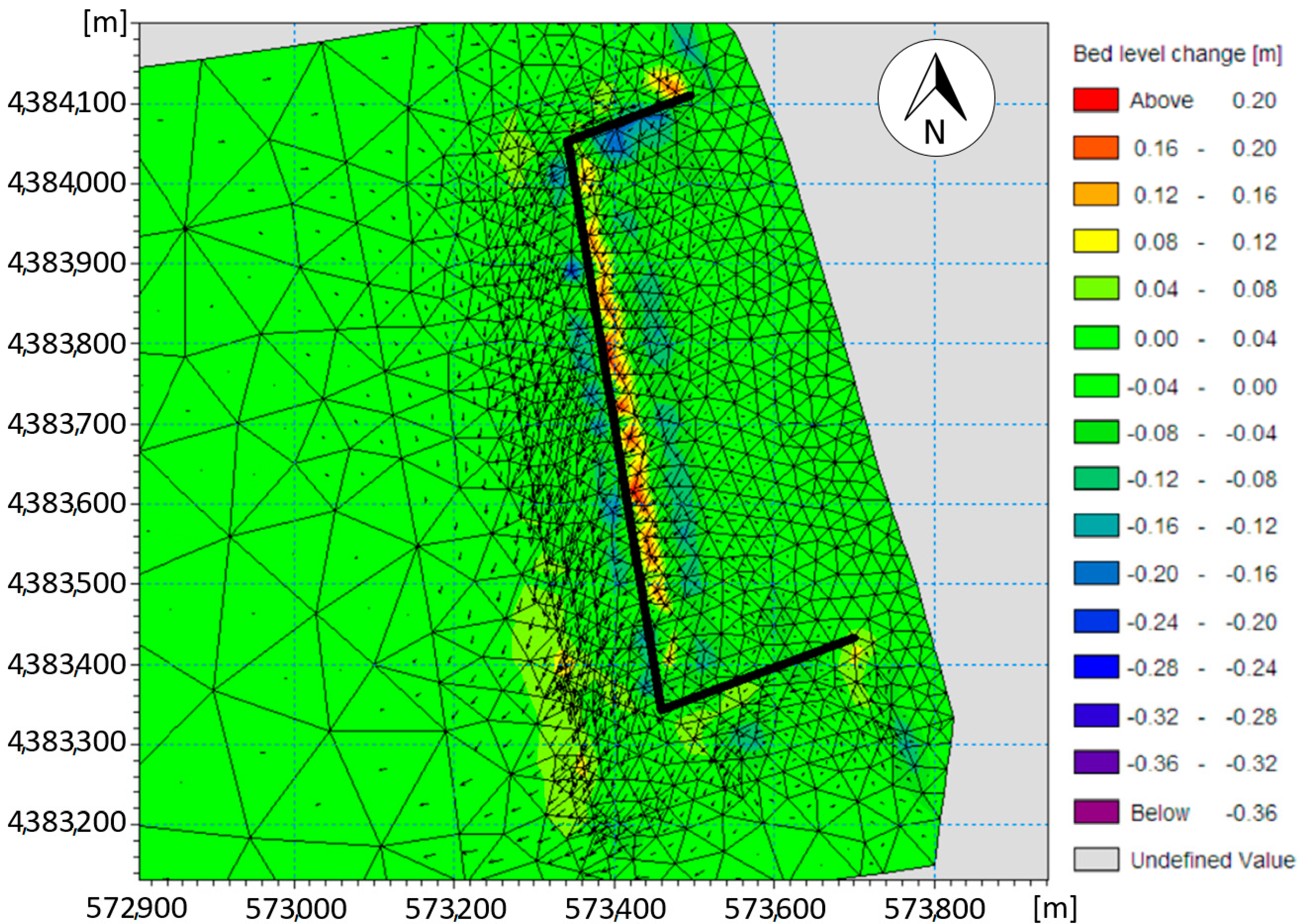
| Hm0 [m] | 3 | 4 | 5 | 6 | 7 |
| Tp [s] | 9.18 | 10.60 | 9.18 | 11.85 | 14.02 |
| Hm0 | Full 2D Model | Beta Values | ||||
|---|---|---|---|---|---|---|
| 0.25 | 0.3 | 0.35 | 0.4 | 0.6 | ||
| 3 | 17.06 | 15.81 | 16.98 | 18.10 | 19.45 | 25.29 |
| 4 | 31.22 | 30.71 | 31.98 | 33.11 | 34.29 | 38.88 |
| 5 | 38.96 | 38.29 | 39.35 | 40.36 | 41.26 | 46.00 |
| 6 | 41.25 | 40.17 | 40.98 | 41.89 | 42.82 | 47.05 |
| 7 | 41.75 | 40.89 | 41.70 | 42.56 | 43.46 | 47.55 |
| RMS Error | 0.908 | 0.404 | 1.23 | 2.27 | 6.97 | |
| Simulated Hm0 [m] | Event Duration [h] | Peak Period [s] | Wave Direction [deg] |
|---|---|---|---|
| 7.20 | 8 | 14.02 | 270 |
| 5.00 | 16 | 11.85 | 270 |
| 2.00 | 32 | 7.49 | 270 |
| 0.25 | 6 months | 2.65 | 270 |
| Hm0 | Event Duration [hours] | Return Time [years] | With Breakwater | Without Breakwater | Ratio of Loss | ||
|---|---|---|---|---|---|---|---|
| Volume Loss [m3] | Mean Elevation Loss [m] | Volume Loss [m3] | Mean Elevation Loss [m] | ||||
| 7.20 | 8 | 200 | −629.40 | −0.00058 | −25245.93 | −0.114 | 40.11 |
| 5.00 | 16 | 50 | −563.94 | −0.00045 | −21671.71 | −0.101 | 38.43 |
| 2.00 | 32 | 0.1 | −1681.02 | −0.0059 | −10910.4 | −0.0502 | 6.49 |
| 0.25 | 6 months | 0.03 | −700.29 | −0.00798 | −13307.92 | −0.06552 | 19.00 |
© 2020 by the authors. Licensee MDPI, Basel, Switzerland. This article is an open access article distributed under the terms and conditions of the Creative Commons Attribution (CC BY) license (http://creativecommons.org/licenses/by/4.0/).
Share and Cite
Maiolo, M.; Mel, R.A.; Sinopoli, S. A Simplified Method for an Evaluation of the Effect of Submerged Breakwaters on Wave Damping: The Case Study of Calabaia Beach. J. Mar. Sci. Eng. 2020, 8, 510. https://doi.org/10.3390/jmse8070510
Maiolo M, Mel RA, Sinopoli S. A Simplified Method for an Evaluation of the Effect of Submerged Breakwaters on Wave Damping: The Case Study of Calabaia Beach. Journal of Marine Science and Engineering. 2020; 8(7):510. https://doi.org/10.3390/jmse8070510
Chicago/Turabian StyleMaiolo, Mario, Riccardo Alvise Mel, and Salvatore Sinopoli. 2020. "A Simplified Method for an Evaluation of the Effect of Submerged Breakwaters on Wave Damping: The Case Study of Calabaia Beach" Journal of Marine Science and Engineering 8, no. 7: 510. https://doi.org/10.3390/jmse8070510







